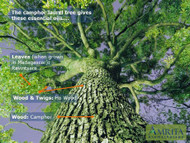What Are Essential Oil Chemotypes?
Apr 21st 2021
Posted by Stephanie Chambers
by Stephanie Chambers and Dr. Christoph Streicher
A chemotype or chemovar is a chemically distinct entity of a plant. Chemotypes have the same genus and species, but the chemical constituents of the plant are different (e.g. they may have different secondary metabolites) due to minor genetic or epigenetic changes. Epigenetics is where different genes in the plant are switched on due to environmental factors.
Your first exposure to this kind of thing might have been with Hydrangeas. Maybe you remember one of your parents telling you that the flower colors—purple, blue, pink, or white—depend on where the plant is grown. Now that you've looked into it a bit more, you’ll see that the color of certain Hydrangea species is influenced by the pH level of the soil and the presence of minerals like iron or aluminum.
When it comes to Essential Oils, the aroma, therapeutic properties, and even safety issues can be affected by the chemotype. Chemotypes are sometimes distinguished by the letters “ct” after the name. There are many examples.
Rosemary ct. camphor or Rosmarinus officinalis ct. camphor refers to the chemotype of rosemary, which contains more camphor. This chemotype is a good choice for muscle aches and pains. Compare this to Rosmarinus officinalis ct. 1,8-cineole, which is a better choice for respiratory issues as it is able to reduce mucous. Rosmarinus officinalis ct. verbenone is thought to be the best rosemary, because it helps improve the function of the liver and is cell regenerator for the skin and anti-spasmodic. It is also less “stimulating” than the other two chemotypes, so it can also be used in the evening.*
Thyme: Thymus vulgaris ct. thymol is traditionally used to kill bacteria and viruses, but it is a strong skin irritant. Inhalation or long-term use is not recommended. Thymus vulgaris ct. linalool (which Amrita sells) however, is also anti-infectious but isn’t as irritating to the skin and can be used on a more long-term basis.*
Basil: This also comes in two chemotypes: Sweet Basil Linalool (Ocimum basilicum ct. linalool) and Tropical Basil (Ocimum basilicum ct. tropical, also known as Basil Exotic, Comoran Basil or Reunion Basil). The Tropical chemotype has a more woody-camphoraceous aroma because it is high in methylchavicol and camphor rather than linalool. Holy Basil is totally different. It is Ocimum sanctum, so it isn’t a chemotype. If it is energy you want, Holy Basil or Tropical Basil are the best to diffuse. If you want to be able to dilute your basil and apply it to your skin and have it in your bath, use Sweet Linalool Basil. If you want to increase faith and compassion, diffuse Holy Basil. If you have a cold or other respiratory issues, diffuse Tropical Basil.*
Lavender Extra: Although not an official chemotype, Dr. Christoph Streicher, the founder of Amrita Aromatherapy and master aromatherapist claims that the Lavender Extra grown in the higher altitudes in France has a superior aroma to that grown in Bulgaria. It is a bit like in a previous blog about organic versus wild-crafted Essential Oils and how people say they can smell the difference within those. You may be interested to know that there is also another lavender species called Lavandula stoechas. It contains ketones. It is quite different from other lavenders. It stimulates circulation and the immune system, is mucus solving and therefore excellent for respiratory infections.*
Camphor: Camphor leaves (Cinnamonum camphora) can be used to produce an Essential Oil called Ravintsara, which is high in cineole and is said to ease congestion and soothe joints and muscles. But this can only be produced from the leaves of the tree when it is grown in Madagascar. Ravintsara is traditionally used for viral infections like colds, flu and shingles. This isn't to be confused with Ravensara Aromatica. The leaves of the tree when grown in other places are not able to produce the same Essential Oil. The wood of Cinnamomum camphora produces Camphor Essential Oil, but it is grown in various places.*
What has your experience been with Essential Oil chemotypes? Please share so all can benefit.
Disclaimer: *The statements made on this page have not been evaluated by the U.S. Food and Drug Administration (FDA). They are not intended to diagnose, cure or prevent any disease. If a condition persists, please contact your physician or healthcare provider. The information provided is not a substitute for a face-to-face consultation with a healthcare provider, and should not be construed as medical advice.
Original Published: 2016-05-29 / Last Modified: 2025-5-22

